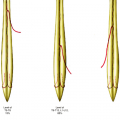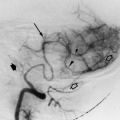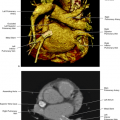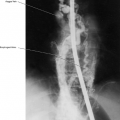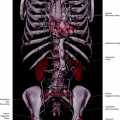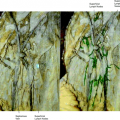Lymphatic System of the Abdomen and Pelvis
There are three main groups of lumbar lymph nodes: the preaortic, lateral aortic (right and left), and retroaortic. The preaortic receives drainage from the ventral splanchnic; the lateral aortic drains the viscera supplied by the lateral splanchnic and dorsolateral somatic vessels. The retroaortic lymph nodes drain no specific territory, but are mainly an interconnection of the other groups (Figs. 21.1, 21.2). The intestinal lymph trunks coalesce and join the right and left lumbar lymph trunks to form the highly variable abdominal confluence of lymph trunks, the cranial end of which is the cisterna chyli in 54% or less of the individuals or the thoracic duct per se. The cisterna chyli has variable morphologic characteristics and sizes. Frequently the cisterna is absent, but when present it can be multilocular or plexiform. A well-formed cisterna chyli can have a square, triangular, or sigmoid format (Fig. 21.3).
Lumbar Lymph Nodes
Preaortic Lymph Nodes
The preaortic lymph nodes comprise the group located anterior to the abdominal aorta and receive the intestinal trunks, named after the arteries with which they are companions. Celiac lymph nodes, superior mesenteric lymph nodes, and inferior mesenteric lymph nodes.
Celiac Lymph Nodes
There are three main groups of lymph nodes sending afferents to the celiac lymph nodes: from gastric lymphatic vessels and nodes (from left gastric nodes, right gastroepiploic nodes, and pyloric nodes) (Fig. 21.4), from hepatic lymphatic vessels and nodes (Fig. 21.5) (from the stomach, duodenum, liver, gallbladder, bile ducts, and head of the pancreas), and from splenopancreatic lymphatic vessels and nodes (from stomach, spleen, and pancreas) (Fig. 21.4).
Superior and Inferior Mesenteric Lymph Nodes
The superior and inferior mesenteric lymph nodes are located close to the origin of the corresponding arteries. They collect lymphatic drainage from the duodenojejunal flexure to the upper anal canal, including the mesenteric, ileocolic, colonic, and pararectal lymph nodes, discharging into the celiac lymph nodes. There are hundreds of lymph nodes in the territory comprising the mesentery. The lymphatic drainage of the rectum and anal canal has a double path. The upper half of the rectum drains to the pararectal nodes and subsequently to the superior mesenteric lymph nodes, whereas the lower half of the rectum and the anal canal drains to the internal iliac lymph nodes. Lymphatic vessels of the mucocutaneous junction reach the medial superficial inguinal nodes (Fig. 21.6).
Lateral Aortic Lymph Nodes
Comprise the group of lymph nodes flanking the abdominal aorta and the inferior vena cava. Several afferents reach those nodes, from the kidney, suprarenal gland, abdominal ureter, posterior abdominal wall, testis, and ovary. The lymph of the pelvic organs reaches the lateral aortic lymph nodes, after passing through regional groups as the internal iliac nodes, external iliac nodes, and common iliac nodes (Fig. 21.7). The internal iliac group receives deep gluteal lymph, and the external iliac group receives the efferents from the inguinal lymph nodes, whereas the common iliac nodes are grouped around the common iliac artery, draining the external and internal iliac nodes and sending efferents to the lateral aortic nodes.
Lymphatic Drainage of the Urinary and Reproductive Organs
From the Kidney
The intrarenal lymphatics of the kidney are divided into a superficial plexus and a deep plexus. The superficial plexus is located immediately below the renal capsule and is connected with cortical lymphatics. In pathologic conditions (pyelonephritis, for example), this plexus may communicate with an extrarenal plexus located in the perirenal fat, which drains, in its turn, into the lumbo-aortic lymph nodes.
The deep plexus is subcortical and also pyramidal (more deeply located). These deep plexuses are perivascular and drain together, along the arcuate and interlobar vessels, converging to the renal hilus. The collecting channels emerge from the renal hilus and, if a polar artery is present, usually a lymphatic channel follows the polar vessel. There are one to four lymphatic channels that emerge from the renal hilus, either anteriorly or posteriorly to the renal vein.
These lymphatics may be anastomosed, giving a plexiform aspect. The lymphatics usually are periarterial, forming an anterior plexus when they come from the kidney ventral surface or a posterior plexus when they come from the kidney dorsal surface. In some cases, the lymphatic channels may connect their lymph nodes directly, without following the arterial branches. The drainage of the lymphatic vessels differs in some aspects between right and left sides:
These lymphatics may be anastomosed, giving a plexiform aspect. The lymphatics usually are periarterial, forming an anterior plexus when they come from the kidney ventral surface or a posterior plexus when they come from the kidney dorsal surface. In some cases, the lymphatic channels may connect their lymph nodes directly, without following the arterial branches. The drainage of the lymphatic vessels differs in some aspects between right and left sides:
Stay updated, free articles. Join our Telegram channel

Full access? Get Clinical Tree



